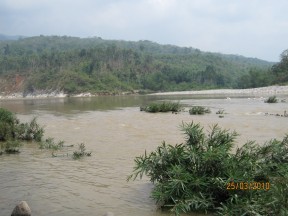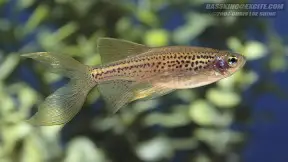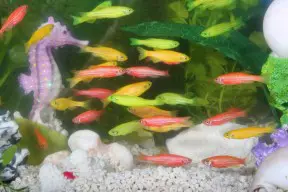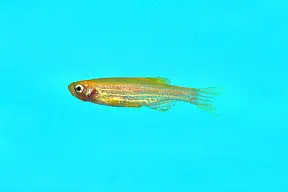Brachydanio rerio
Zebra 'Danio'
SynonymsTop ↑
Brachydanio frankei Meinken, 1963; Danio rerio (Hamilton, 1822); Cyprinus chapalio Hamilton, 1822; Cyprinus rerio Hamilton, 1822; Danio lineatus Day, 1868; Perilampus striatus McClelland, 1839
Etymology
Brachydanio: from the Ancient Greek βραχύς (brakhús), meaning ‘short’, and Dhani, a Bengalese vernacular term for small, minnow-like cyprinids.
rerio: appears to be derived from a local vernacular name for the species.
Classification
Order: Cypriniformes Family: Cyprinidae
Distribution
Described from the Kosi River, a tributary of the Ganges system in Uttar Pradesh state, northern India.
It was traditionally considered to range westwards from Pakistan though India (with Karnataka State representing the southern extent of its range) as far as Myanmar, thus also occurring in Nepal, Bhutan and Bangladesh, but current knowledge suggests a more restricted distribution.
The primary reason for this is that many older records almost certainly represent misidentification of other species. In Myanmar, for example, the last record of D. rerio was in 1926, but in the years since several new, similar-looking fishes have been discovered and described to science, with others still to follow.
Agriculture, industry, modern fishing methods involving industrial reagents and other forms of habitat degradation may also have adversely affected its range.
At any rate it may be restricted to India (with the Eastern/Western Ghats mountain ranges representing its southern limit), Bangladesh and possibly Bhutan.
This area is subjected to seasonal rainfall between the months of June and September due to the southwestern summer monsoon meaning habitats vary considerably depending on the time of year.
Wild caught fish have virtually disappeared from the aquarium trade since it’s more cost-effective to produce on a commercial basis.
As a result it’s become one of the most heavily-farmed species in the hobby, now available in several artificial forms (see ‘Notes’), and invariably very cheap to buy. If you want wild specimens some specialist retailers carry them sporadically.
Habitat
A 2007 survey by Engeszer et al. recorded D. rerio at 28 sites in north-eastern India and found that in half of them water flow was either slow or non-existent.
The most common substrate-type was silt, submerged/overhanging vegetation was typical and generally the fish were more abundant in marginal/seasonally-inundated pools and mature rice paddies than stream or river channels.
When they were observed in flowing streams with rocky substrates they tended to school in marginal zones with overhanging vegetation. The water in most habitats was clear or relatively clear, only occasionally turbid.
Sympatric species across the localities included Opsarius barna, B. bendelisis, Danio dangila, Devario assamensis, D. devario, Laubuca laubuca, Esomus danricus, Pethia conchonius, P. shalynius, Oreichthys sp. ‘sail fin‘, Lepidocephalichthys annandalei, L. guntea, Badis blosyrus, Dario dario, Colisa chuna, Ctenops nobilis, Aplocheilus panchax plus unidentified members of Oryzias and Lepidocephalichthys. Potential predators comprised various Channa species, Mastacembelus armatus, Mystus bleekeri, Xenentodon cancila and Notopterus notopterus.
The authors’ final hypothesis as to the life cycle of the zebra danio was that adults spend dryer months of the year in permanent streams and minor rivers. There they inhabit calmer, shaded areas before migrating into seasonally-inundated tributaries, marginal pools and rice paddies during the monsoon to spawn.
The latter are typified by dense growths of flooded vegetation and silty substrates, and the young fish remain there until the flood waters begin to recede.
Maximum Standard Length
Usually 40 – 50 mm.
Aquarium SizeTop ↑
An active species so even a small group needs an aquarium with minimum base dimensions of 90 ∗ 30 cm.
Maintenance
Choice of décor is not especially critical though it tends to show better colouration in a heavily-planted set-up with a dark substrate.
The addition of some floating plants and driftwood roots or branches to diffuse the light entering the tank also seems to be appreciated and adds a more natural feel.
Filtration does not need to be particularly strong given its natural habitat preferences though it does seem to appreciate a degree of water movement.
Water Conditions
Temperature: The temperature range in its native waters was recorded to be 76.2 – 101.5°F/24.6 – 38.6°C during the month of July but presumably drops somewhat during winter. For general maintenance a value of 18 – 25 °C should suffice meaning a heater may not always be required.
pH: 6.0 – 8.0
Hardness: 90 – 357 ppm
Diet
Stomach analyses of wild specimens have shown it to be a micropredator, feeding on aquatic crustaceans and other invertebrates such as mosquito larvae.
In the aquarium it is unfussy and will accept just about anything offered. Offer a balanced diet comprising good quality dried products along with small live and frozen foods such as Daphnia, Artemia and bloodworm.
Behaviour and CompatibilityTop ↑
This species is very peaceful indeed and can be combined with many of the most popular fish in the hobby including other small cyprinids as well as tetras, livebearers, rainbowfishes, anabantoids, catfishes and loaches.
As always when selecting a compatible community of fishes thorough research is essential, and its small adult size must be a consideration.
It is a schooling species by nature and should be maintained in a group of at least 8-10 specimens.
Maintaining it in decent numbers will not only make the fish less nervous but result in a more effective, natural-looking display while males will also display their best colours as they compete with one other for female attention
Sexual Dimorphism
Sexually mature females are usually rounder-bellied, slightly less colourful and a little larger than males.
The differences are especially clear when the fish are in spawning condition as the males intensify in colour and the females fill with eggs.
Reproduction
An excellent choice for those new to breeding fishes in aquaria. Like many small cyprinids it is an egg-scattering spawner that exhibits no parental care.
When the fish are in good condition they should spawn often and in a densely-planted, mature aquarium it is possible that small numbers of fry may start to appear without human intervention, but if you want to increase the yield of fry a slightly more controlled approach is required.
The adult group can still be conditioned together but one or more smaller containers should also be set up and half-filled with water.
These should be very dimly lit and the base covered with some kind of mesh of a large enough grade so that the eggs can fall through it but small enough so that the adults cannot reach them.
The widely available plastic ‘grass’-type matting can also be used and works very well; alternatively filling much of the tank with Java moss or other fine-leaved plant can also yield good results.
The water itself should be of slightly acidic to neutral pH with a temperature towards the upper end of the range suggested above.
A small power filter can be added initially and this should be positioned so that the flow is directed down the full length of the tank.
When the adult fish are well-conditioned and the females appear full of eggs one or two pairs should then be introduced to each container.
Spawning can be initiated by adding small amounts of cool water every few hours in such a way that the tank is gradually topped up and feeding small amounts of live and frozen foods.
The pair should spawn the following morning. The easiest and quickest way to tell is simply to look at the female. If the fish have spawned she will be noticeably slimmer.
The adults will eat any eggs they find and are best removed after a couple of days at which point the power filter should be switched for a mature sponge-type unit in order to avoid fry being sucked into the mechanism.
Incubation is temperature-dependant to an extent but usually takes between 24 and 36 hours with the young free-swimming a few days later.
Initial food should be Paramecium or a proprietary dry food of sufficiently small (5-50 micron diameter) grade, introducing Artemia nauplii, microworm, etc., once the fry are large enough to accept them.
NotesTop ↑
B. rerio is one of the most popular and ubiquitous fishes in the aquarium hobby, and its popularity is well deserved since it is peaceful, hardy and inexpensive.
Unfortunately it has been mass-produced in huge numbers for many years, thus inbreeding has occurred on a large scale and quality stock can be hard to find.
Alongside morphological deformities common ailments include ‘neon tetra disease’ (NTD), caused by the microsporidian parasite Pleistophora hyphessobryconis and basically untreatable once it reaches an advanced stage.
Symptoms include restlessness, increased respiration, white patches on the skin, and an individual separating itself from the group. The spores (larval stage) of the parasite enter the fish through the mouth and burrow through the walls of the gut before settling in the muscles. There they produce cysts which cause rapid degeneration of the muscle tissue and development of the characteristic white patches.
Once the disease takes hold mortality rates can rapidly become very high. No medication is available, and the only way to ‘treat’ the tank is to physically remove any fish displaying symptoms.
Similar symptoms are caused by a severe form of the pathogenic bacterium Flavobacterium columnare, and this is sometimes mistaken for NTD (Michel, Messiaen, and Bernardet, 2002).
Another common problem is microsporidiosis, caused by the parasite Pseudoloma neurofilia (Matthews et al. 2001), with external symptoms including chronic emaciation and curvature of the spine having led to the vernacular term ‘skinny disease’. Its life-cycle is similar to that of F. columnare in that it is ingested orally, but the main site of infection is the central nervous system, and it can be tricky to diagnose since infestations have been recorded in seemingly healthy individuals.
The ‘leopard danio’ is a spotted morph of B. rerio which was described as Brachydanio frankei (Meinken, 1963), but is now generally referred to as B. rerio var. frankei. Its origin was considered something of a mystery for a number of decades, with the most accepted theory being that it was produced via selective breeding, but it is now known to be a spontaneous mutation of the striped form which also occurs in the wild (Spence et al., 2008). There do exist several ornamental strains, however, including a xanthistic ‘golden’ form and a long-finned variety.
More recently, transgenically-modified ‘Glofish’ which flouresce constantly have appeared on the market.
These were originally produced by the National University of Singapore in an attempt to mutate a fish so that it would literally glow in the presence of certain environmental toxins and are available in a number of colours, including yellow, green and red.
The substances causing this effect are proteins extracted from a particular jellyfish (green and yellow forms) or coral species (red form). An American company quickly purchased the rights to market Glofish in the United States where they’ve achieved a fair level of popularity.
As things stand they’re illegal to buy, sell or own within the European Union although several instances of smuggling have been recorded, the punishment for which is a hefty fine.
B. rerio is a commonly-used model organism in scientific research, particularly the fields of vertebrate ontogeny and gene function, and is one of the few fishes to have been launched into space!
In recent years it’s become commonplace to refer to the stripes on the body and fins of danionins as follows:
– P stripe: or “pigment stripe” is the central, dark, lateral stripe on the body which extends into the caudal-fin in some species. Stripes above it are numbered P+1, P+2, etc. and those beneath P-1, P-2, P-3.
– A stripe: the central stripe on the anal-fin; the proximal stripe (above it) is A+1 and the distal stripe (beneath) A-1.
– D stripe: The submarginal dorsal-fin stripe.
Following Fang (2003) Brachydanio spp. are characterised by the presence of an A stripe on the anal-fin and two or more P stripes on the caudal, plus some internal characteristics such as enlarged nasal lamellae.
The genus has undergone some significant taxonomic reshuffling in recent years following the publication of a series of phylogenetic studies.
Older, molecular, phylogenies tended to agree that it represented a monophyletic group consisting of two major clades; the ‘Danio devario‘ group containing the larger, deeper-bodied species and the ‘D. rerio‘ clade comprising the smaller, slimmer fish.
However in 2003 Fang conducted a more detailed study based on morphological characters which included members of other related genera, and the results suggested for the first time that the genus Danio as previously considered represents a polyphyletic grouping, i.e., not all members derived from a single common ancestor.
The genus name Devario was suggested for the larger species with Danio being applied only to the smaller fish (with the exception of the type species, D. dangila which can grow to around 89 mm SL). Recent molecular studies by Mayden et al. (2007) and Fang et al. (2009) resulted in further changes, with the latter study considering the genus Danio to be composed of three subclades. These were subsequently split into distinct genera by Kottelat (2013), as follows:
The former species D. erythromicron, D. margaritatus, D. choprae and D. flagrans are grouped together in the revalidated genus Celestichthys Roberts, 2007. These exhibit unique body patterning consisting of vertical bars (C. erythromicron, C. choprae, C. flagrans) or light spots (C. margaritatus) and possess either very short barbels or none at all.
The genus Danio contains only the type species, D. dangila, separated on the basis of its larger size and the shape of the caudal-fin, which in adults is only slightly emarginate or even truncate in shape, a feature it shares only with Tinca tinca (the common tench) among other cyprinids.
The remaining species, of which B. rerio is thought to be the most ancient, are included in the revalidated genus Brachydanio Weber & de Beaufort, 1916.
References
- Hamilton, F., 1822 - Edinburgh & London: i-vii + 1-405, Pls. 1-39
An account of the fishes found in the river Ganges and its branches. - C. Michel, S. Messiaen, and J-F. Bernardet, 2002 - Journal of Fish Diseases: 253-263
Muscle infections in imported neon tetra, Paracheirodon innesi Myers: limited occurrence of microsporidia and predominance of severe forms of columnaris disease caused by an Asian genomovar of Flavobacterium columnare. - Conway, K. W., W.-J. Chen and R. L. Mayden, 2008 - Zootaxa 1686: 1-28
The 'Celestial Pearl danio' is a miniature Danio (s.s) (Ostariophysi: Cyprinidae): evidence from morphology and molecules. - Dahanukar, R., R. Raut and A. Bhat, 2004 - Journal of Biogeography 31(1): 123-136
Distribution, endemism and threat status of freshwater fishes in the Western Ghats of India. - Engeszer, R. E., L. B. Patterson, A. A. Rao and D. M. Parichy, 2007 - Zebrafish 4(1): 21-40
Zebrafish in the wild: a review of natural history and new notes from the field. - Fang, F., 2003 - Copeia 2003(4): 714-728
Phylogenetic Analysis of the Asian Cyprinid Genus Danio (Teleostei, Cyprinidae). - Fang, F., M. Norén, T. Y. Liao, M. Källersjö and S. O. Kullander, 2009 - Zoologica Scripta 38(1): 1-20
Molecular phylogenetic interrelationships of the south Asian cyprinid genera Danio, Devario and Microrasbora (Teleostei, Cyprinidae, Danioninae). - Kottelat, M., 2013 - The Raffles Bulletin of Zoology Supplement 27: 1-663
The fishes of the inland waters of southeast Asia: a catalogue and core bibiography of the fishes known to occur in freshwaters, mangroves and estuaries. - Kullander, S. O. and F. Fang, 2009 - Zootaxa 2164: 41-48
Danio aesculapii, a new species of danio from south-western Myanmar (Teleostei: Cyprinidae). - Kullander, S. O., T. Y. Liao, and F. Fang, 2009 - Ichthyological Exploration of Freshwaters 20(3): 193-199
Danio quagga, a new species of striped danio from western Myanmar (Teleostei: Cyprinidae). - Matthews J.L., A. M. Brown, K. Larison, J. K. Bishop-Stewart, P. Rogers, and M. L. Kent, 2001 - Journal of Eukaryotic Microbiology 48(2): 227-233
Pseudoloma neurophilia n. g., n. sp., a New Microsporidium from the Central Nervous System of the Zebrafish (Danio rerio). - Mayden, R. L., K. L. Tang, K. W. Conway, J. Freyhof, S. Chamberlain, M. Haskins, L. Schneider, M. Sudkamp, R. M. Wood, M. Agnew, A. Bufalino, Z. Sulaiman, M. Miya, K. Saitoh, S. He, 2007 - Journal of Experimental Zoology, Molecular Development and Evolution 308B: 642–654
Phylogenetic relationships of Danio within the order Cypriniformes: a framework for comparative and evolutionary studies of a model species. - Meinken, H., 1963 - Monatsschrift für Ornithologie und Vivarienkunde 42: 39-43
Mitteilungen der Fischbestimmungsstelle des VDA XLII: Brachydanio frankei spec. nov., der Leopard-Danio. - Rema Devi, K., and T. J. Indra, 2003 - Zoos' Print Journal 18(4): 1067-1070
An updated checklist of ichthyofauna of Eastern Ghats. - Roberts, T. R., 2007 - Raffles Bulletin of Zoology 55 (1): 131-140
The 'Celestial Pearl Danio', a new genus and species of colourful minute cyprinid fish from Myanmar (Pisces: Cypriniformes). - Spence, R., G. Gerlach, C. Lawrence, and C. Smith, 2008 - Biological Reviews 83(1): 13-34
The behaviour and ecology of the zebrafish, Danio rerio. - Spence, R., M. K. Fatema, M. Reichard, K. A. Huq, M. W. Wahab, Z. F. Ahmed and C. Smith, 2006 - Journal of Fish Biology 69(5): 1435-1448
The distribution and habitat preferences of the zebrafish in Bangladesh.














July 27th, 2012 at 7:26 am
Hello there,
You might want to update your information on zebrafish diseases. You mention neon tetra disease, but do not mention its relative, Pseudoloma neurophilia, which is one of the two major infections of zebrafish in research labs. It also seems to be widespread in hobbyist fish. Here (http://zebrafish.org/zirc/health/diseaseManual.php#Microsporidiosis) is a link to the zebrafish disease manual which contains a lot of information on this disease (and many others).
July 27th, 2012 at 9:32 am
Hi Bill, thanks a lot for the feedback and link, I’ve just made some changes to the profile text.
July 30th, 2012 at 2:28 pm
Matt, with neon tetra disease you probably mean a sporozoan disease Pleistophora hyphessobryconis (and not Flavobacterium columnare, which is bacterium)?
You wrote: “The spores (larval stage) of the parasite enter the fish through the mouth and burrow through the walls of the gut before settling in the muscles.” This is possible only for sporozoan parasite, not for bacterium.
July 30th, 2012 at 3:28 pm
Yeah that’ll need editing Bojan, and think the issue is down to my poor interpretation of this paper a few years ago. Seems Flavobacterium can cause symptoms similar to those of Pleistophora, but of course they’re not the same disease. Thanks for pointing it out!
July 30th, 2012 at 4:36 pm
Better now?
July 30th, 2012 at 10:11 pm
Yes, it is good now…
November 27th, 2014 at 8:22 pm
I accidentaly found that the “leopard danio” mutation is observed in wild populations! This confirms what is widely speculated, that it is a colour variety and not a valid species. Because of this, it appears possible that the first leopard danio’s which appeared in the hobby were either wildcaught or offspring of wild caught fish which were heterozygous for the trait. The “leopard danio” should be considered as a rare natural variation rather than an ornamental variety. You can find the article here (with notes on behaviour in nature and on habitats):
http://darchive.mblwhoilibrary.org/bitstream/handle/1912/2698/Spence%20et%20al%20zebrafish%20final%20draft_combined.pdf?sequence=1
November 29th, 2014 at 3:54 pm
Thanks for the link! Will update now.
January 24th, 2016 at 7:38 pm
I’m afraid your taxonomy of this species is wrong. It’s in the abstract of one of your own references:
The well-known genus Brachydanio becomes a junior synonym of Danio (sensu stricto).
So it stays Danio. Same goes for other species on this website. From another paper in these references:
We herein place Celestichthys in the synonymy of Danio, preserving monophyly of that group, as also suggested by Conway et al. (2008) based on nuclear sequences and morphology. Danio erythromicron is sister to D. rerio in the phylogeny of Rüber et al. (2007).
January 24th, 2016 at 8:30 pm
Hi Jos yes, we are aware – just haven’t got around to updating this yet. Thanks for the heads up and will try to make this a priority. The name change to Brachydanio was based on Kottelat (2013) but it has since been placed back in Danio (or at least referred to as a member of that genus) by several subsequent authors.
March 28th, 2017 at 9:59 pm
I had five zebra danios in my tank, all normal colored, wild type fish. A while ago I discovered a young fish between the plants which I raised and has turned out to be of the leopard variety. Probably makes sense since it is a mutation, but I found it interesting to mention none the less. Do you think the parents had leopard type danios among their ancestors or could it really occur just randomly in any zebra danio offspring? Does anyone else have a similar experience?